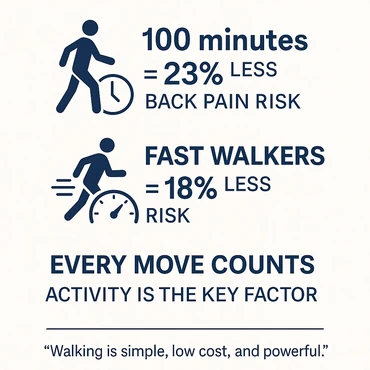Researchers say its an easy and cost-effective way to manage pain
-
A new study found that daily walking up to 100 minutes may lower the risk of developing chronic low back by 23%.
-
Researchers found that speed can also play a role, as fast walkers were less likely than slow walkers to develop chronic back pain.
-
The findings point to the benefits associated with consistent physical activity.

A walk a day may keep the doctor away.
A new study conducted by researchers from Norwegian University of Science and Technologys Department of Public Health and Nursing explored the benefits of daily walking on lower back pain.
The team found that consistently walking every day up to 100 minutes each day can lower the risk of developing low back pain by 23%.
Our study shows that higher daily walking volume lowers the risk of developing chronic low back pain, researcher Rayane Haddadj told ConsumerAffairs. The relationship was dose-dependent meaning the more people walked, the lower their risk up to about 100 minutes per day, after which the benefit levelled off.
The study
For the study, the researchers analyzed data from over 11,000 participants in the population-based Norwegian HUNT cohort. At the start of the study, all of the participants were free of chronic low back pain.
Participants were involved in the study for about four years, and they wore accelerometers to measure their daily walking volume. Throughout the study, the participants also completed questionnaires to report on their lower back pain.
The results
Ultimately, the researchers found a link between walking and chronic lower back pain. The more the participants walked, the lower their risk of developing chronic lower back pain.
The study identified the sweet spot for people to walk each day to help ward off back pain. Those who walked between 78 and 100 minutes were 13% less likely to develop chronic lower back pain. Those who did 100 minutes or more each day were 23% less likely to develop chronic lower back pain.
This is an important finding because walking is a simple, low cost, and accessible activity that can be promoted widely to reduce the burden of low back pain, Haddaj told ConsumerAffairs.
Speed plays a role too
Additionally, speed was an important factor here. Fast walkers were as much as 18% less likely to develop back pain as slow walkers.
However, the most important finding: activity is key. Regardless of speed, consistent walking every day was the biggest indicator of staving off back pain.
Our results reinforce a growing body of evidence showing that physical activity is essential for long-term health, Haddaj told ConsumerAffairs. Even small increases in daily activity can make a difference; or, as the World Health Organization puts, Every move counts towards better health.
Walking more could therefore be a simple yet powerful way to reduce risk of chronic low back pain and other diseases.
Posted: 2025-06-20 16:15:22




















